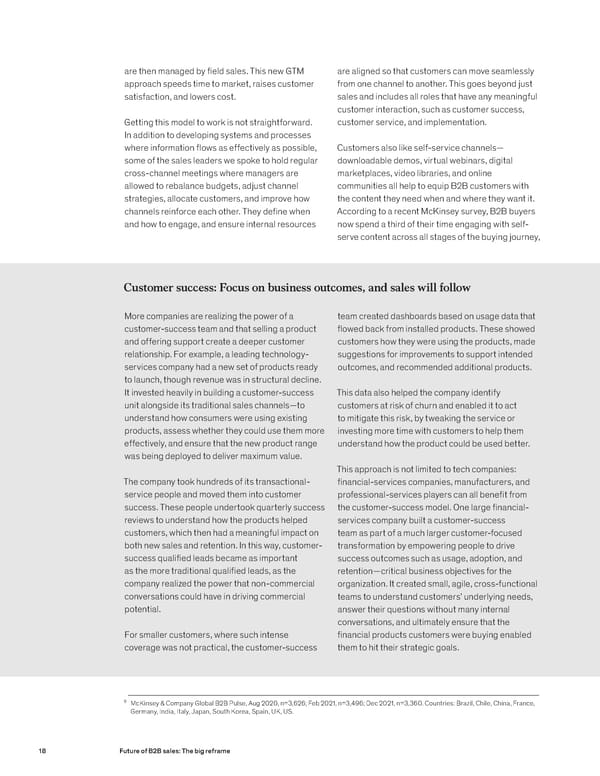are then managed by field sales. This new GTM are aligned so that customers can move seamlessly approach speeds time to market, raises customer from one channel to another. This goes beyond just satisfaction, and lowers cost. sales and includes all roles that have any meaningful customer interaction, such as customer success, Getting this model to work is not straightforward. customer service, and implementation. In addition to developing systems and processes where information flows as effectively as possible, Customers also like self-service channels— some of the sales leaders we spoke to hold regular downloadable demos, virtual webinars, digital cross-channel meetings where managers are marketplaces, video libraries, and online allowed to rebalance budgets, adjust channel communities all help to equip B2B customers with strategies, allocate customers, and improve how the content they need when and where they want it. channels reinforce each other. They define when According to a recent McKinsey survey, B2B buyers and how to engage, and ensure internal resources now spend a third of their time engaging with self- serve content across all stages of the buying journey, Customer success: Focus on business outcomes, and sales will follow More companies are realizing the power of a team created dashboards based on usage data that customer-success team and that selling a product flowed back from installed products. These showed and offering support create a deeper customer customers how they were using the products, made relationship. For example, a leading technology- suggestions for improvements to support intended services company had a new set of products ready outcomes, and recommended additional products. to launch, though revenue was in structural decline. It invested heavily in building a customer-success This data also helped the company identify unit alongside its traditional sales channels—to customers at risk of churn and enabled it to act understand how consumers were using existing to mitigate this risk, by tweaking the service or products, assess whether they could use them more investing more time with customers to help them effectively, and ensure that the new product range understand how the product could be used better. was being deployed to deliver maximum value. This approach is not limited to tech companies: The company took hundreds of its transactional- financial-services companies, manufacturers, and service people and moved them into customer professional-services players can all benefit from success. These people undertook quarterly success the customer-success model. One large financial- reviews to understand how the products helped services company built a customer-success customers, which then had a meaningful impact on team as part of a much larger customer-focused both new sales and retention. In this way, customer- transformation by empowering people to drive success qualified leads became as important success outcomes such as usage, adoption, and as the more traditional qualified leads, as the retention—critical business objectives for the company realized the power that non-commercial organization. It created small, agile, cross-functional conversations could have in driving commercial teams to understand customers’ underlying needs, potential. answer their questions without many internal conversations, and ultimately ensure that the For smaller customers, where such intense financial products customers were buying enabled coverage was not practical, the customer-success them to hit their strategic goals. 6 McKinsey & Company Global B2B Pulse, Aug 2020, n=3,626; Feb 2021, n=3,496; Dec 2021, n=3,360. Countries: Brazil, Chile, China, France, Germany, India, Italy, Japan, South Korea, Spain, UK, US. 18 Future of B2B sales: The big reframe
 Future of B2B sales The big reframe Page 17 Page 19
Future of B2B sales The big reframe Page 17 Page 19